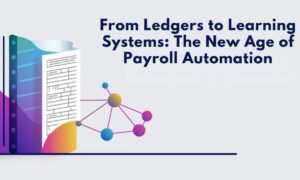Payroll management is an essential aspect of any business, involving a variety of complex tasks and calculations. Traditionally, managing payroll meant spending countless hours manually processing employee wages, tax deductions, and compliance requirements. However, with the advent of technology, payroll software has emerged as a game-changer in how organizations handle their payroll operations. In this blog post, we will delve into the fascinating world of payroll system, highlight its functionalities, and explain how it simplifies and streamlines the entire payroll process.
How does payroll software work?
Payroll software automates and streamlines the process of managing employee salaries, tax deductions, benefits, and other related aspects. The software typically begins by collecting and storing employee data, such as personal information, salary details, and tax information. It then uses this data to calculate gross pay based on predefined pay structures, including allowances, deductions, and bonuses.
The software incorporates tax rules and statutory requirements to calculate tax deductions for each employee accurately. It generates pay slips and other necessary documents, which the employees can easily access through a self-service portal. Payroll software also integrates with accounting systems to ensure seamless transfer of payroll data for financial reporting purposes. Additionally, it offers features such as leave and attendance management, investment proof verification, and customizable reporting, enabling businesses to efficiently manage their payroll operations while maintaining compliance with applicable laws and regulations.
Bureau payroll software, in particular, enhances these capabilities by providing a robust platform tailored to the specific needs of businesses, ensuring that every aspect of payroll processing is handled with precision and efficiency.
Why do Organisations use payroll software?
Organizations use payroll software for a variety of reasons. Here are some key points:
- Time and efficiency: Payroll software automates manual tasks, saving time and reducing the risk of errors. It streamlines salary calculation, tax deduction, and pay slip preparation, helping HR teams focus on strategic initiatives.
- Compliance: Payroll software covers tax regulations and statutory requirements, ensuring accurate tax calculations and generating required reports and forms. It helps organizations comply with changing tax laws and avoid penalties.
- Accuracy and Transparency: Payroll software provides accurate salary calculations considering factors such as allowances, deductions, and bonuses. It generates transparent and detailed pay slips and improves employee confidence and satisfaction.
- Self-Service Portal: Payroll software provides a self-service portal for employees to access pay slips, submit leave requests, and update personal information. It empowers employees, reduces HR workload, and enhances communication.
- Reporting and Analytics: Payroll software generates customizable reports and analytics, providing insights into payroll data, trends, and costs. It helps organizations make informed decisions and supports financial planning.
How does payroll software help businesses?
Payroll software provides many advantages to businesses. Here are some key points:
- Reduces Errors: Payroll software reduces the risk of human errors in payroll calculations, tax deductions, and other payroll-related tasks. Payroll software helps businesses avoid costly mistakes and ensure accurate and consistent payroll processing.
- Time Efficiency: By automating payroll processes, the software significantly reduces the time required for manual data entry, calculations, and paperwork. Payroll software frees up valuable time for HR teams to focus on other essential tasks and strategic initiatives.
- Enhanced Security: Payroll software provides secure data storage and backup options, protects sensitive employee information, and ensures data privacy. Payroll software helps businesses maintain compliance with data privacy regulations.
- Efficient record-keeping: Payroll software maintains systematic and easily accessible payroll data records, including employee details, salary history, tax documents, and other related information. It simplifies audits, compliance checks, and record-keeping requirements.
- Better decision-making: The comprehensive reporting and analytics features of payroll software enable businesses to gain insight into payroll costs, trends, and financial implications. This data-driven approach aids in decision-making, budgeting, and resource allocation.
How does payroll software help with taxes, compliance, and regulations?
Payroll software helps companies to navigate the complexities of taxes, compliance, and regulations by automating key processes and ensuring accuracy. It incorporates tax laws and regulations in its calculations, reducing the risk of errors and ensuring accurate tax deductions for employees. The software generates tax forms such as Form 16 or W-2 with the necessary information for businesses and employees. By maintaining up-to-date knowledge of tax regulations, payroll software helps companies to stay compliant with changing tax laws, avoiding penalties and legal issues.
Additionally, the software generates reports and maintains records that assist in audits and compliance checks carried out by tax authorities or regulatory bodies. It simplifies the process, saves time, and ensures that businesses meet their obligations while reducing non-compliance risk. Overall, payroll software is a trusted partner in navigating tax requirements, ensuring compliance, and reducing the burden of regulatory complexities for businesses.
What qualities should organizations look for in payroll software?
When considering payroll software, organizations should look for several key features to meet their needs.
- First, robust payroll calculation capabilities are essential, allowing for accurate and flexible calculations based on different pay structures, deductions, and benefits.
- Additionally, the software should provide tax compliance functionality, stay up-to-date with tax regulations, and automate tax calculations and filings.
- Integration capabilities are critical, enabling seamless data exchange with other systems, such as human resources and accounting software.
- Employee self-service features empower employees to access and manage their payroll information, reducing the administrative burden.
- Customizable reporting and analytics provide insight into payroll costs, trends, and compliance while aiding decision-making.
- Security measures protect sensitive employee information, including data encryption and access control.
- Finally, excellent customer support and regular updates or enhancements from the software provider contribute to a seamless user experience and the ability to adapt to changing needs.
By considering these features, organizations can choose payroll software that streamlines operations, increases compliance, and meets their unique needs.
Conclusion
Payroll software is vital in streamlining and automating organizational payroll processes. It simplifies managing employee compensation, ensuring accuracy and compliance with tax and regulatory requirements. By integrating various functions and features, HR & Payroll solutions increase efficiency, reduce errors, and provide valuable benefits to businesses.
Payroll software functions by centralizing employee data, calculating wages, deductions, and taxes, and generating payslips. It automates repetitive tasks such as calculating hours worked, applying tax rates, and generating reports, saving significant time and effort for HR and payroll departments. With real-time data updates and accurate calculations, payroll software minimizes the risk of errors and discrepancies.



































